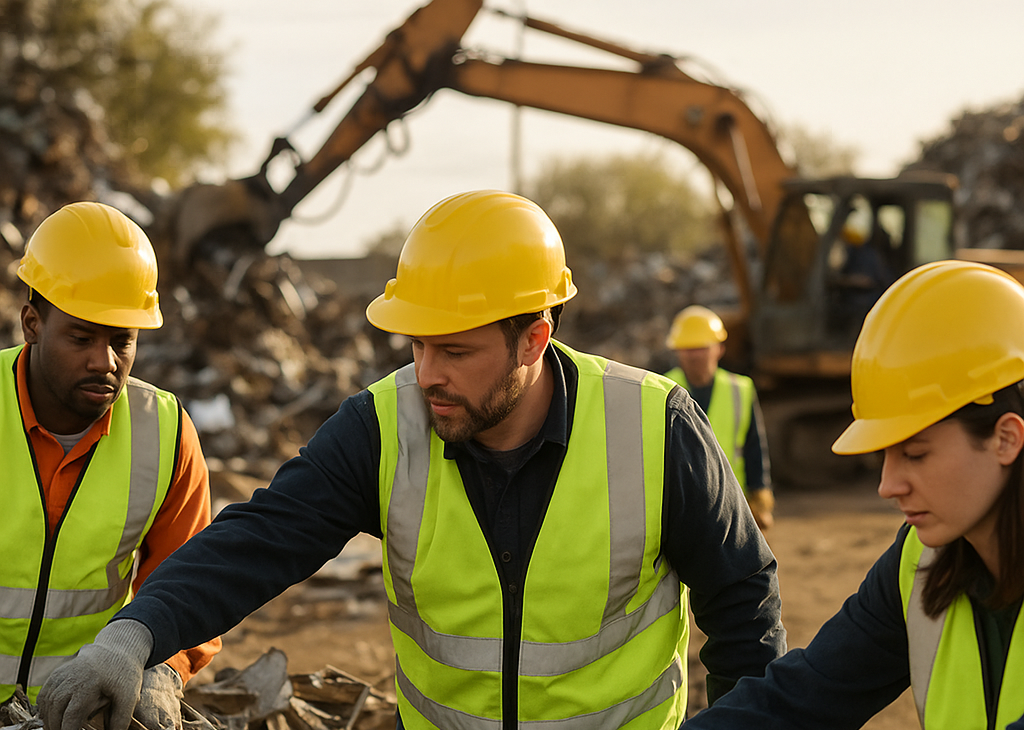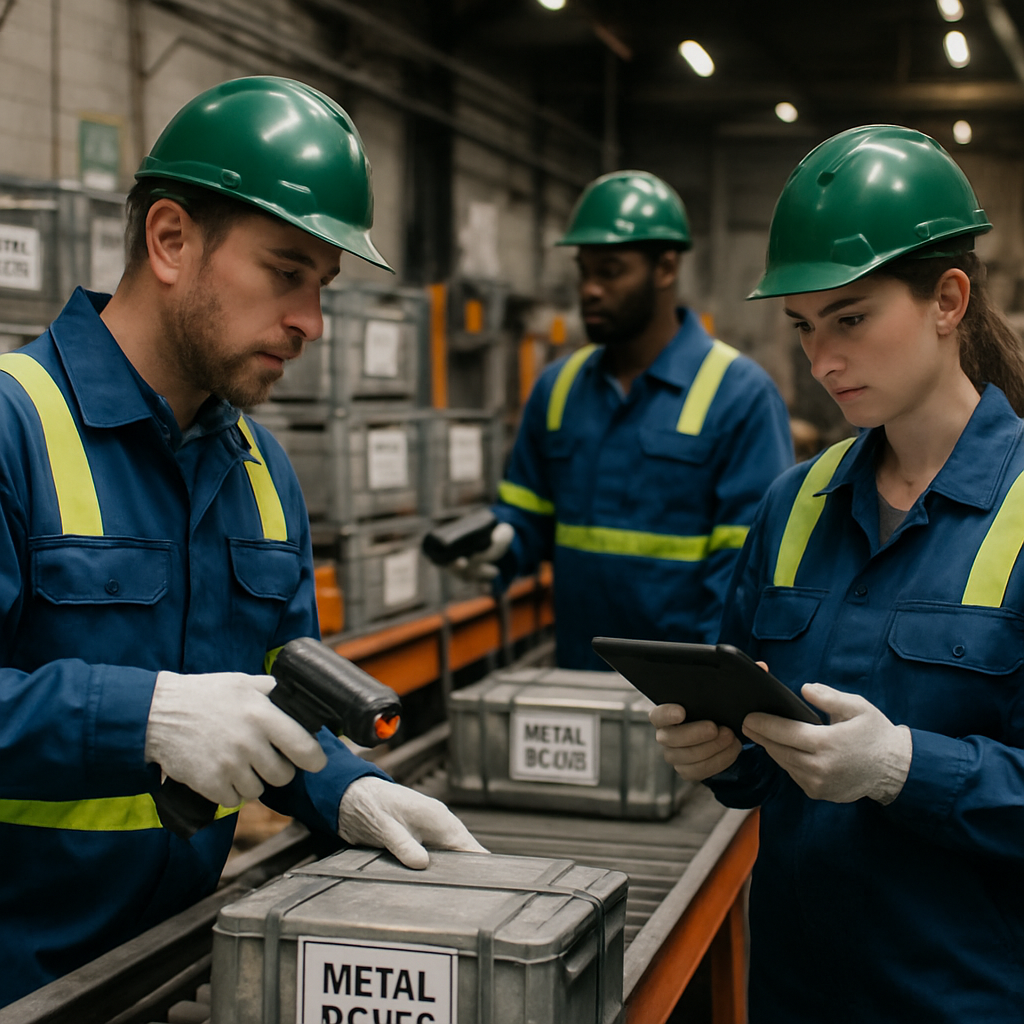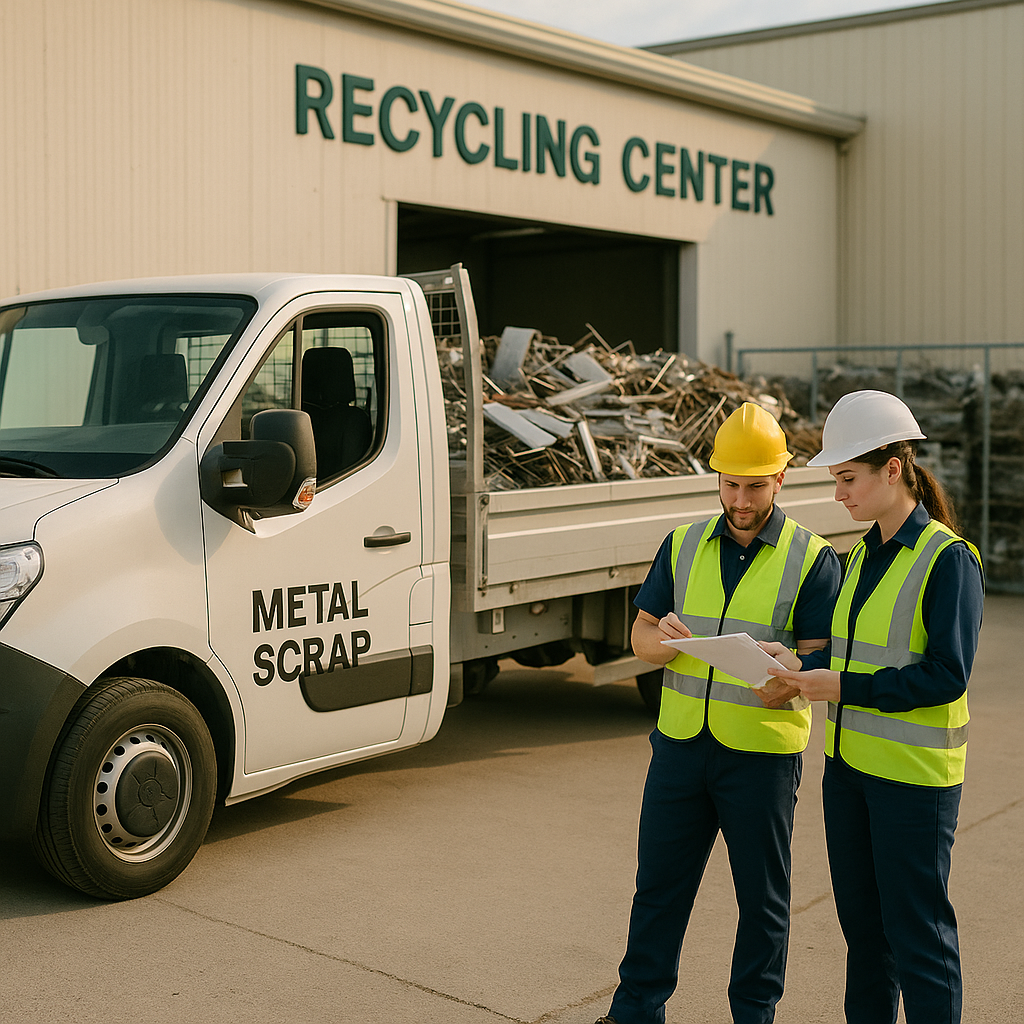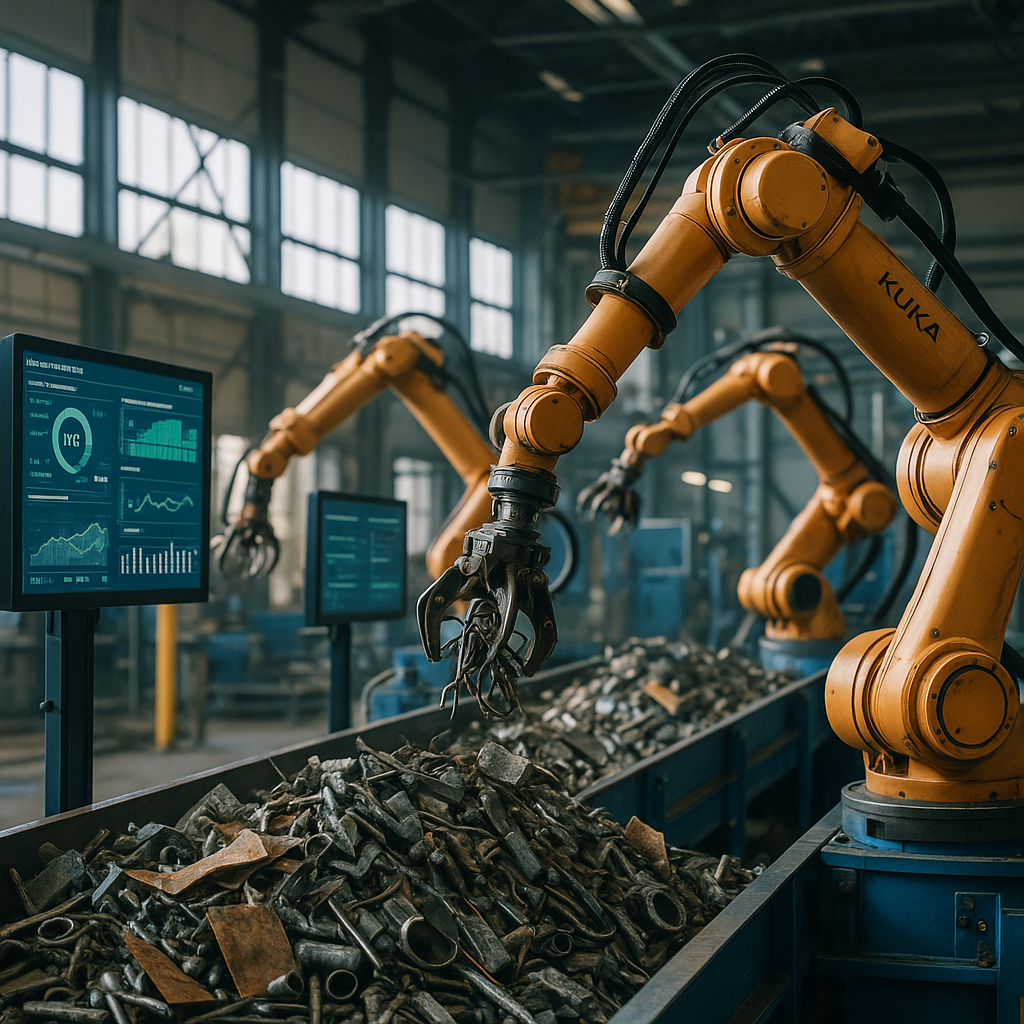5901 Botham Jean Blvd, Dallas, TX 75215
Metal Recycling Chain of Custody: Steps, Technology & Key Benefits
October 27, 2025The metal recycling chain of custody is a crucial tracking system documenting the journey of metal materials from the moment they enter the recycling stream to their transformation into new products. This uninterrupted documentation captures each transfer, processing step, and transformation throughout the metal’s recycling journey.
Think of it as a metal’s biography. Just as a passport shows travel history, a proper chain of custody details each location metal materials have been, who has handled them, and what transformations they have undergone. This system ensures accountability at every stage of the recycling process, from collection bins at municipal facilities to sorting centers, processing plants, and ultimately to manufacturers creating new products.
The importance of this tracking system has grown as businesses and governments face increased pressure to verify sustainability claims. Without a documented chain of custody, there’s no reliable way to prove that metal materials are being recycled rather than landfilled or improperly disposed of. This transparency has become not just an environmental consideration but a business imperative for organizations aiming to meet regulatory requirements and sustainability goals.
What Are the Key Steps in the Metal Recycling Chain of Custody?

Workers diligently sorting metal scrap in a recycling facility, ensuring safety with vests and helmets.
The metal recycling chain of custody represents a systematic approach to tracking materials from collection to final processing. This documented pathway ensures the integrity, quality, and sustainability of recycled metals throughout their journey.
Collection
The chain begins with collection, which involves gathering metal materials from various sources, including industrial scrap, construction debris, post-consumer waste, and end-of-life products containing valuable metals.
Collection methods vary based on the source and type of metal. Municipal recycling programs typically handle household metals, while specialized industrial recycling services manage larger commercial volumes.
During this stage, initial documentation creates the first link in the chain of custody. Records should identify the source, estimated volume, and preliminary metal types collected.
Sorting and Identification
Once collected, metals undergo thorough sorting processes. Modern recycling facilities use both manual inspection and advanced technologies to separate metals by type.
Electromagnetic sorting systems identify ferrous materials, while eddy current separators handle non-ferrous metals. X-ray fluorescence analyzers determine precise metal composition for high-value materials.
This stage requires detailed documentation of the sorted materials. Each batch receives identification markers to maintain traceability as it moves through subsequent processes.
Processing
The processing stage transforms sorted metals into usable raw materials. This involves several operations, including shredding, melting, and purification.
Shredding reduces metals to manageable sizes for efficient handling. Melting then converts solid metal into liquid form, where impurities can be removed. The resulting metal meets quality specifications for manufacturing applications.
Comprehensive records during processing document transformation methods, quality control measures, and yield rates. These records verify that materials maintain their integrity throughout physical changes.
Final Disposition
The final stage involves the transfer of processed recycled metals to end users or manufacturers. This completes the recycling loop and returns valuable resources to the production stream.
At this point, final certification documents verify the material’s journey through the recycling process. These certificates often include composition analysis, processing methods, and compliance with relevant industry standards.
The documentation established during final disposition provides manufacturers with confidence in the quality and origin of their recycled metal inputs.
Documentation Requirements
Effective chain of custody systems rely on thorough documentation throughout each stage. This documentation serves multiple purposes beyond simple tracking.
Key documentation elements include transfer receipts, processing records, quality testing results, and final certification. These documents verify compliance with environmental regulations and industry standards.
Modern tracking systems increasingly use digital platforms and blockchain technology to create tamper-proof records. These innovations enhance transparency and build trust among all stakeholders in the recycling chain.
Maintaining Chain Integrity
Preserving the integrity of the metal recycling chain requires strict adherence to established protocols. These protocols ensure consistency, accuracy, and reliability throughout the process.
Regular audits by internal teams and third-party certifiers verify compliance with chain of custody requirements. These assessments identify potential weaknesses and opportunities for improvement.
Staff training programs ensure all personnel understand their responsibilities in maintaining proper documentation and following established procedures.
| Stage | Documentation Requirements |
|---|---|
| Collection | Initial documentation of source, estimated volume, and metal types. |
| Sorting and Identification | Detailed documentation with identification markers for each batch. |
| Processing | Comprehensive records of transformation methods, quality control, and yield rates. |
| Final Disposition | Final certification documents verifying the material’s recycling journey. |
The metal recycling chain of custody provides essential verification of material sourcing, handling, and processing. This verification supports sustainability claims, regulatory compliance, and quality assurance for recycled metal products.
How Does Technology Enhance the Metal Recycling Chain of Custody?

Advanced technologies are reshaping how the metal recycling industry tracks materials from collection through processing to reuse. This digital transformation creates seamless chains of custody that enhance accountability, efficiency, and value recovery.
Barcode scanning is one of the most widely adopted technological solutions in metal recycling facilities. By assigning unique identifiers to material batches, recyclers can quickly access crucial information about metal type, origin, and processing history. This reduces manual record-keeping errors and accelerates intake processes. When scrap metal arrives at a facility, operators simply scan attached barcodes to automatically update inventory systems and maintain accurate material flow records.
Digital logbooks have replaced traditional paper-based systems, allowing real-time tracking of materials across multiple facilities. These electronic records create tamper-resistant documentation of chains of custody, capturing timestamps, handler identifications, and material transformations at each stage. For large recycling operations spanning multiple locations, digital logbooks enable centralized monitoring of all material movements, significantly reducing the risk of loss or theft in the supply chain.
Blockchain technology offers a significant advancement for metal recycling traceability. By creating immutable, decentralized records of every transaction, blockchain provides unmatched transparency across the entire recycling process. Each participant in the recycling chain—from collectors to processors to end users—can verify the precise path materials have taken, ensuring compliance with environmental regulations and ethical sourcing standards.
The application of blockchain in metal recycling is already showing promising results. For example, some metal recycling firms use blockchain to certify the origin and quality of recycled metals, providing customers with detailed verification reports of sustainability claims. This technology removes the need for intermediaries and manual record-keeping, streamlining operations and reducing administrative costs while maintaining accurate records.
Smart contracts—self-executing agreements with terms coded directly into them—automate key recycling processes. In metal recycling, smart contracts can trigger payment releases upon verified delivery of recycled materials, reducing delays and minimizing disputes. These automated systems ensure transactions proceed fairly and transparently, with all details permanently recorded on the blockchain.
IoT (Internet of Things) sensors further enhance the metal recycling chain of custody by monitoring physical conditions throughout the process. Sensors attached to containers, processing equipment, and transportation vehicles collect real-time data on material location, weight, and quality. When integrated with blockchain systems, this creates a comprehensive digital twin of the physical recycling process, where every material movement is automatically recorded and verified.
Together, these technologies create multi-layered verification systems that are transforming how recycled metals are tracked, traded, and trusted. A single ton of recycled aluminum can now carry with it a complete, tamper-proof history of its journey from collection to processing to remanufacturing. This digital trail increases confidence in recycled materials and supports premium pricing for verified sustainably-sourced metals.
For recycling facility operators, these technological solutions lead to tangible business benefits: reduced processing times, lower administrative overhead, fewer disputes, and enhanced regulatory compliance. For consumers and manufacturers, they provide assurance that recycled materials meet quality standards and sustainability claims. The metal recycling industry is quickly moving toward systems where complete material traceability becomes the standard, driven by these powerful and increasingly accessible digital tools.
| Technology | Benefit |
|---|---|
| Barcode Scanning | Instant access to critical information, eliminates manual errors, accelerates intake processes |
| Digital Logbooks | Real-time tracking, tamper-resistant documentation, centralized monitoring |
| Blockchain | Immutable and decentralized records, transparency, elimination of intermediaries |
| Smart Contracts | Automated payment releases, reduce delays and disputes |
| IoT Sensors | Real-time data on material conditions; integrated with blockchain for comprehensive tracking |
What Are the Benefits of a Strong Metal Recycling Chain of Custody?

A robust chain of custody in metal recycling offers significant advantages across environmental, regulatory, and economic dimensions. This systematic documentation of material transfer ensures accountability at every stage of the recycling process. The benefits extend beyond simple record-keeping to fundamental improvements in sustainability practices and business operations.
Improved Sustainability Performance
A strong chain of custody enhances sustainability by verifying proper recycling protocols. This system ensures claimed environmental benefits are realized, rather than existing only on paper.
Metal recycling with proper documentation leads to substantial resource conservation. Recycling steel reduces waste by 76% compared to primary production, while aluminum recycling saves about 95% of the energy needed to produce new aluminum from bauxite ore. These environmental gains are verifiable through a transparent chain of custody.
The greenhouse gas reduction benefits are equally impressive. The recycling industry cuts CO₂ emissions by about 29 million tons annually—equivalent to removing 6.3 million cars from the road. For individual metals, the impact is significant: recycling one ton of aluminum prevents 9 tons of CO₂ emissions, while each ton of steel recycling reduces emissions by 2 tons.
Enhanced Regulatory Compliance
Metal recycling faces complex regulatory requirements at federal, state, and local levels. A comprehensive chain of custody system provides the documentation necessary to demonstrate compliance across various frameworks.
Documentation requirements include material identification records, transportation manifests, weight certificates, training documentation, and environmental permits. Each document evidences proper handling practices during regulatory inspections or audits.
According to industry compliance experts, facilities using professional scrap services with strong documentation typically reduce compliance deficiencies by 50-70% compared to self-managed programs. This significant reduction in compliance risk directly protects businesses from potential penalties that can exceed $10,000 per day in states with strict regulations like California.
Fraud Prevention and Risk Mitigation
The chain of custody significantly reduces fraud risks throughout the metal recycling process. By tracking materials from source to final processing, it becomes much harder to introduce illicit materials or misrepresent recycled metals.
This tracking is crucial for regulated metal categories that require specialized handling, such as materials with mercury, lead, or other hazardous components. Proper documentation ensures these materials receive appropriate treatment.
The chain of custody also protects businesses from liability associated with improperly handled materials. Should questions arise, a complete chain of custody provides evidence of proper procedures and due diligence, potentially shielding businesses from costly legal challenges.
Enhanced Quality Control
Quality assurance in recycled metal depends heavily on knowing the exact composition and source of materials. A strong chain of custody enables precise tracking of different metal types and grades, ensuring they meet required specifications.
Modern chain of custody systems incorporate advanced sorting technologies like X-ray fluorescence analyzers that quickly identify and catalog metal types. This technology increases sorting efficiency and provides detailed documentation of material composition, ensuring the final recycled product meets quality standards.
The quality benefits extend to manufacturers who use recycled metals. With verified documentation of material sources and processing methods, manufacturers can confidently incorporate recycled content while maintaining product quality and performance standards.
Optimized Resource Allocation
Detailed chain of custody documentation generates valuable data for more efficient resource allocation throughout the recycling process. This data helps businesses identify opportunities to streamline operations, reduce waste, and optimize material recovery.
For example, transportation efficiency improves when materials are properly documented and categorized. Loads can be optimized based on material types, reducing unnecessary movement and associated fuel consumption and emissions. According to industry data, optimized logistics can reduce transportation costs by 15-20% while simultaneously decreasing the carbon footprint of recycling operations.
The economic advantages are substantial. Using recycled steel can reduce production costs by 33% compared to virgin materials, but these savings depend on having properly sorted and documented materials. The chain of custody ensures these economic benefits are realized while maintaining environmental integrity.
Increased Stakeholder Trust
Perhaps the most valuable benefit of a strong chain of custody is the trust it builds among stakeholders. Customers, investors, regulators, and community members all gain confidence in recycling operations that maintain transparent documentation of material handling.
This trust translates into tangible business advantages. Companies with verifiable sustainability practices through documented chain of custody often enjoy enhanced brand reputation. Studies show that sustainability practices influence purchasing decisions for over 60% of consumers, making transparent documentation a competitive advantage.
Investors increasingly evaluate environmental performance when making investment decisions. Strong chain of custody systems demonstrate responsible resource management, potentially improving access to capital from sustainability-focused investors.
| Model | Advantages | Disadvantages |
|---|---|---|
| Identity Preservation | Ensures uniqueness and value; premium value; transparent; trust; shares stories of producers. | Complex and costly; requires strict separation; high logistical needs. |
| Segregation | Maintains characteristics; premium value; transparent; trust. | More logistics involved; strict separation needed. |
| Mass Balance | Low-cost barrier; scalable; supports large production; flexible sourcing. | No physical traceability; complex auditing; risk of false claims. |
| Book and Claim | Lowest entry cost; high flexibility; supports large production. | Least credibility; potential for greenwashing; no physical connection. |
The benefits of a strong metal recycling chain of custody ultimately create a positive feedback loop that strengthens the entire recycling ecosystem. Better documentation leads to improved processes, higher quality recycled materials, and greater stakeholder confidence, which in turn drives higher recycling rates and additional environmental benefits.
Conclusion: The Future of Metal Recycling Chain of Custody

As sustainability becomes a central focus in global industrial practices, the metal recycling chain of custody plays a key role in environmental stewardship. Comprehensive documentation and traceability systems ensure recycled metals move through the supply chain with full accountability and transparency, fostering stakeholder confidence. Technological advancements, including blockchain, AI-powered monitoring, and digital certification, are transforming how recycled materials are tracked and verified, enhancing reliability and reducing the risk of fraud or contamination.
Standardizing metal recycling chain of custody protocols across industries and regions will be critical to achieving the full environmental and economic benefits of the circular economy. As companies increasingly value transparent supply chains, these systems will continue to evolve to meet the growing demand for responsible sourcing and sustainability compliance. For recycling needs and to participate in this sustainable future, contact Okon Recycling at 214-717-4083.
